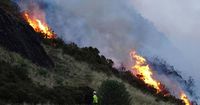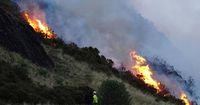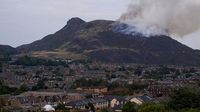On Sunday afternoon, August 10, 2025, as the city of Edinburgh pulsed with the energy of the world-famous Edinburgh Festival Fringe and music fans flocked to sold-out Oasis concerts at Murrayfield Stadium, a different kind of spectacle unfolded on the city’s historic skyline. A massive wildfire erupted across Arthur’s Seat, the iconic extinct volcano that rises dramatically above the Scottish capital, sending plumes of smoke billowing into the sky and prompting a swift and determined response from emergency crews.
The Scottish Fire and Rescue Service (SFRS) was first alerted to the blaze just after 4:00pm, a time when the landmark’s trails were bustling with hikers and tourists. According to the SFRS, the fire quickly swept across a large area of gorse bushes—those dense, thorny evergreens that blanket the hill’s slopes. As the flames took hold, visitors found themselves racing down the hillside to escape the fast-spreading danger. One eyewitness told Edinburgh Live, “There is a major wildfire on Arthur’s Seat which is spreading rapidly. People are running down the face of the hill to get away from it and smoke is spreading really fast.”
Nick Brice, a visitor from Brighton, described the scene to BBC Scotland News: “We could see this little plume of smoke on the ridge at the far side and it just got bigger and bigger. All of a sudden we could see these flames starting to come up and people noticed it spreading fast. The smoke started to really build and then these flames started to cover the ridge and we realised the wind was blowing it right towards us. We had to get down to the road fast because it was going to come across the whole area.” Brice said he urged those still climbing the hill to turn around, warning them of the oncoming flames.
By the time night fell, the fire had left a dramatic mark on the city’s skyline. Large plumes of smoke were visible from miles away, with the flames lighting up the darkening sky above Holyrood Park, just a stone’s throw from the Scottish Parliament and the historic Old Town. The SFRS mobilized four fire appliances and specialist resources to the scene, working through the night and into Monday morning to contain the blaze and dampen down hotspots. As of the latest update, two fire appliances remained at Arthur’s Seat, ensuring that the fire’s remnants did not reignite.
Miraculously, despite the speed and size of the fire, no casualties were reported. The SFRS urged the public to stay away from the area, both for their own safety and to allow emergency crews to continue their work unimpeded. The swift response and coordination among fire crews likely prevented a far worse outcome, especially given the sheer number of people in the vicinity due to the city’s busy festival season.
Arthur’s Seat, named after the legendary King Arthur, is more than just a scenic viewpoint. Rising to 823 feet (251 meters) and located about a mile from Edinburgh Castle, it’s a beloved spot for locals and tourists alike. Its popularity has soared in recent years, thanks in part to its appearance in the Netflix adaptation of David Nicholls’ novel One Day. The hill’s unique geology as an extinct volcano and its sweeping views over the capital make it a magnet for hikers, photographers, and anyone seeking a breath of fresh air above the urban bustle.
But that very popularity, combined with this summer’s unusually warm and dry weather, may have contributed to the disaster. According to fire science expert Rory Hadden of the University of Edinburgh, “The large number of people visiting and the very dry conditions are therefore a good mix for a wildfire to start and to spread.” Hadden, speaking to the Associated Press, noted that most fires in Scotland are started by human actions, whether accidental or otherwise. He added that wildfires in and around Arthur’s Seat occur relatively often, and that such incidents are becoming more frequent across the UK, driven by climate and land use changes.
The cause of Sunday’s blaze remains unclear, but the timing and conditions were certainly ripe for trouble. This summer has seen Scotland endure a string of wildfires, with three “off the scale” blazes in the Highlands less than six weeks ago, and a vast-scale fire in the north in July that even prompted a police investigation. The UK Health Security Agency has issued a yellow heat health alert for parts of England, with temperatures forecast to reach as high as 34°C (93°F) in the days following the Arthur’s Seat fire. Such heatwaves, once rare in Scotland, are becoming more common, raising concerns about future wildfire risks.
This is not the first time Arthur’s Seat has been scorched by wildfire. In February 2019, a similar blaze broke out, burning about 800 square meters and taking firefighters eight hours to bring under control. The recurrence of such incidents, especially in the context of increasingly dry summers, is a stark reminder of the changing climate and the challenges it poses for both urban and rural communities in Scotland and beyond.
Scottish Fire and Rescue Service Group Commander Niall MacLennan confirmed the scale of the affected area, emphasizing the difficulties posed by the terrain and vegetation. “We were alerted at 4.05pm on Sunday, August 10 to reports of a fire in the open at Arthur’s Seat, Edinburgh. Operations control mobilised four fire appliances and specialist resources to the area where firefighters are working to extinguish a fire affecting a large area of gorse. There are no reported casualties at this time and crews remain at the scene.”
As the city recovers and festival-goers return to their celebrations, the impact of the Arthur’s Seat wildfire lingers. For many, it’s a sobering lesson in the fragility of even the most familiar landscapes. The combination of human activity, climate change, and natural beauty creates a complex and sometimes volatile mix—one that demands vigilance, preparation, and respect for the environment.
For now, Arthur’s Seat stands, blackened but unbowed, as a reminder of both the power of nature and the resilience of those who work to protect it. As Edinburgh’s festival season continues, so too does the conversation about how best to safeguard the city’s treasured landmarks for future generations.



